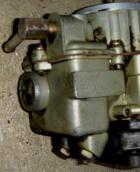| Revision as of 08:23, 13 January 2012 ddgonzal (Talk | contribs) <- Previous diff |
Revision as of 08:42, 13 January 2012 ddgonzal (Talk | contribs) Next diff -> |
||
| Line 7: | Line 7: | ||
| [http://datsun1200.com/modules/myalbum/photo.php?lid=5919 http://datsun1200.com/modules/myalbum/photos/thumbs/5919.jpg] | [http://datsun1200.com/modules/myalbum/photo.php?lid=5919 http://datsun1200.com/modules/myalbum/photos/thumbs/5919.jpg] | ||
| + | |||
| + | = Carburetor Adjustment = | ||
| + | The 1978 carburetors are adjusted exactly the same as the original Datsun 1200 carburetor except for the idle speed RPM number. | ||
| + | |||
| + | After obtain the idle RPM spec, see the main article: [[Carburetor Adjustment]]. | ||
| = North America = | = North America = | ||
| Line 76: | Line 81: | ||
| 2 or 3 hose connectors near top of carburetor | 2 or 3 hose connectors near top of carburetor | ||
| <br>http://ddgonzal.members.winisp.net/getThumb.aspx?width=400&uri=http://datsun1200.com/uploads/photos/23417.jpg | <br>http://ddgonzal.members.winisp.net/getThumb.aspx?width=400&uri=http://datsun1200.com/uploads/photos/23417.jpg | ||
| - | http://datsun1200.com/uploads/photos/23417.jpg | ||
| For testing at low altitudes, remove the hoses and plug the ports coming out of the casting. The carburetor will run as normal. | For testing at low altitudes, remove the hoses and plug the ports coming out of the casting. The carburetor will run as normal. | ||
| Line 83: | Line 87: | ||
| == Vacuum Hoses == | == Vacuum Hoses == | ||
| + | |||
| + | === Vacuum Advance === | ||
| + | Vacuum advance port is always the lowest of any ports on the carburetor. | ||
| + | |||
| + | The Vacuum advance port is just above the mixture screw | ||
| + | <br>[http://datsun1200.com/modules/myalbum/photo.php?lid=5919 http://ddgonzal.members.winisp.net/getThumb.aspx?width=400&uri=http://datsun1200.com/uploads/photos/2214.jpg] | ||
| + | |||
| + | Testing: Plug this port and raise RPMs to 1200. If the engine runs at fast idle better than before, the hoses or vaccum advance canister is leaking or connected incorrectly. | ||
| + | |||
| + | You can drive the car with this plugged, but fuel economy and part-throttle power will be down slightly. | ||
| + | |||
| + | === EGR Signal Port === | ||
| + | [[EGR]] | ||
| + | |||
| + | === Choke Pull-Off === | ||
| + | This long black hose goes to the choke pull-off diaphragm. | ||
| + | <br>http://ddgonzal.members.winisp.net/getThumb.aspx?width=400&uri=http://datsun1200.com/uploads/photos/23417.jpg | ||
| + | |||
| + | Testing: Pull the lower end of this hose off the carburetor, and plug the port. If the engine now idles better, either the hose is leaking or more likely the choke pull-off diaphragm is leaking. The latter is very common with 20-year old+ carburetors. | ||
| + | |||
| + | You can drive the car with this plugged, but after a cold start it will run very rich for some seconds until the choke warms up. | ||
Revision as of 08:42, 13 January 2012
B210 used Hitachi DCH306 carburetor for 1978.
Contents |
Carburetor ID
The ID is inked (not stamped) on this boss on the carburetor:
Carburetor Adjustment
The 1978 carburetors are adjusted exactly the same as the original Datsun 1200 carburetor except for the idle speed RPM number.
After obtain the idle RPM spec, see the main article: Carburetor Adjustment.
North America
5-speeds are exclusive to the FU Engine model, with unique carburetors, jetting and support for maximum fuel economy.
All B210 use A14 engine.
ALL 1978 B210 Carburetor Type: DCH306 (H = Automatic Choke) Throttle Bores: 26/30 Primary/Secondary Venturis: 23/27 Float level: 19mm Float drop h: 1.3-1.5mm Choke: center mark Choke resistance: 3.7-8.9 @ 21C (70F) Ports: * EGR port * Vacuum advance port * Choke pull-off port
California
Manual Transmission: DCH306-11 Auto Transmission: DCH306-15
Main bleeds: 95/80 Slow jets: 45/50
DCH306-11 (M/T) Main jets: 105/145 Power jet: 40
DCH306-15 (A/T) Main jets: 104/145 Power jet: 48
Comments: M/T is much richer at full throttle, slightly leaner at cruising.
Canada
4-speed: same as USA 5-speed: same as USA Automatic: DCH306-12, jetted same as USA Automatic
USA
4-speed: DCH306-60 5-speed: DCH306-37 Automatic: DCH306-14
DCH306-60 (4-speed) Main jets: 104/145 Air bleeds: 110/80 Power jet: 48 Comments: Jetted Richer than CAL m/t
DCH306-37 (5-speed) Main jets: 107/145 Air bleeds: 65/60 Power jet: 48 Comments: Jetted Richer than 4-speed
DCH306-14/DCH306-12 (Auto transmission) Main jets: 104/145 Air bleeds: 95/80 Power jet: 40 Comments: Same as CAL auto except leaner full-throttle
Altitude Compensator
CAL models and all models sold in USA high altitude counties.
2 or 3 hose connectors near top of carburetor

For testing at low altitudes, remove the hoses and plug the ports coming out of the casting. The carburetor will run as normal.
See main article: Altitude_Compensator
Vacuum Hoses
Vacuum Advance
Vacuum advance port is always the lowest of any ports on the carburetor.
The Vacuum advance port is just above the mixture screw

Testing: Plug this port and raise RPMs to 1200. If the engine runs at fast idle better than before, the hoses or vaccum advance canister is leaking or connected incorrectly.
You can drive the car with this plugged, but fuel economy and part-throttle power will be down slightly.
EGR Signal Port
Choke Pull-Off
This long black hose goes to the choke pull-off diaphragm.

Testing: Pull the lower end of this hose off the carburetor, and plug the port. If the engine now idles better, either the hose is leaking or more likely the choke pull-off diaphragm is leaking. The latter is very common with 20-year old+ carburetors.
You can drive the car with this plugged, but after a cold start it will run very rich for some seconds until the choke warms up.

![[Datsun 1200 encyclopedia]](/wiki/upload/wiki.png)
